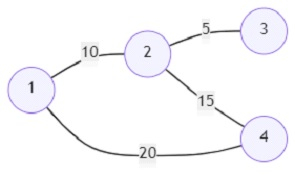
 Data Structure
Data Structure Networking
Networking RDBMS
RDBMS Operating System
Operating System Java
Java MS Excel
MS Excel iOS
iOS HTML
HTML CSS
CSS Android
Android Python
Python C Programming
C Programming C++
C++ C#
C# MongoDB
MongoDB MySQL
MySQL Javascript
Javascript PHP
PHP
- Selected Reading
- UPSC IAS Exams Notes
- Developer's Best Practices
- Questions and Answers
- Effective Resume Writing
- HR Interview Questions
- Computer Glossary
- Who is Who
Program to find out the path between two vertices in a graph that has the minimum penalty (Python)
Suppose we are given an undirected, weighted graph and are asked to find out the path with the minimum possible penalty from node a to node b. The penalty of a path is the bitwise OR of the weights of all the edges in the path. So, we must find out such a 'minimum penalty' path, and if there exists no path between the two nodes, we return -1.
So, if the input is like

start (s) = 1, end (e) = 3; then the output will be 15.
There exist two paths between vertices 1 and 3. The optimal path is 1->2->3, the cost of the path is (10 OR 5) = 15.
To solve this, we will follow these steps −
- Define a function helper() . This will take G, s, e
- v := a new set
- c := a new list of size n initialized with value infinity
- heap := a new heap containing pair (0, s)
- while size of heap > 0, do
- cst := pop the smallest item from heap
- cur := pop the smallest item from heap
- c[cur] := minimum of (cst, c[cur])
- if (cst, cur) is present in v, then
- go for the next iteration
- if cur is same as e, then
- return c[cur]
- add pair (cst, cur) to v
- for each neighbor, n_cost in G[cur], do
- push values ((n_cost OR cst), neighbor) to heap
- return c[e]
- G := [a new list containing n + 1 emoty lists]
- for each item in edges, do
- u := item[0]
- v := item[1]
- w := item[2]
- insert pair (v, w) at the end of G[u]
- insert pair (u, w) at the end of G[v]
- ans := helper(G, s, e)
- return -1 if ans is same as inf otherwise return ans
Example
Let us see the following implementation to get better understanding −
import heapq from math import inf def helper(G, s, e): v = set() c = [inf] * len(G) heap = [(0, s)] while len(heap) > 0: cst, cur = heapq.heappop(heap) c[cur] = min(cst, c[cur]) if (cst, cur) in v: continue if cur == e: return c[cur] v.add((cst, cur)) for neighbor, n_cost in G[cur]: heapq.heappush(heap, (n_cost | cst, neighbor)) return c[e] def solve(n, edges, s, e): G = [[] for _ in range(n + 1)] for item in edges: u, v, w = map(int, item) G[u].append((v, w)) G[v].append((u, w)) ans = helper(G, s, e) return -1 if ans == inf else ans print(solve(4, [(1, 2, 10), (2, 3, 5), (2, 4, 15), (1, 4, 20)], 1, 3))
Input
4, [(1, 2, 10), (2, 3, 5), (2, 4, 15), (1, 4, 20)], 1, 3
Output
15

Advertisements
